How to Unclog a Toilet Without a Plunger (in 3 Easy Steps)
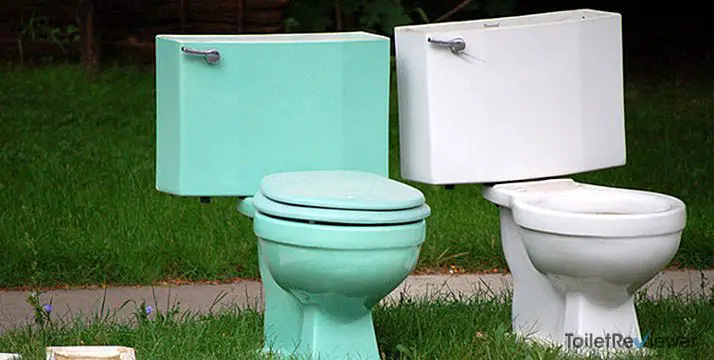
A clogged toilet can happen at any time. Everything from large toilet paper clumps to a foreign object can clog the toilet’s u-bend, stopping the water from flowing.
In most clogged toilet cases, people reach for the plunger which sometimes is a messy solution.
When your toilet becomes clogged, air gets trapped inside the u-bend area, When you push the plunger down and pull it out, pressure pushes the water out and towards you.
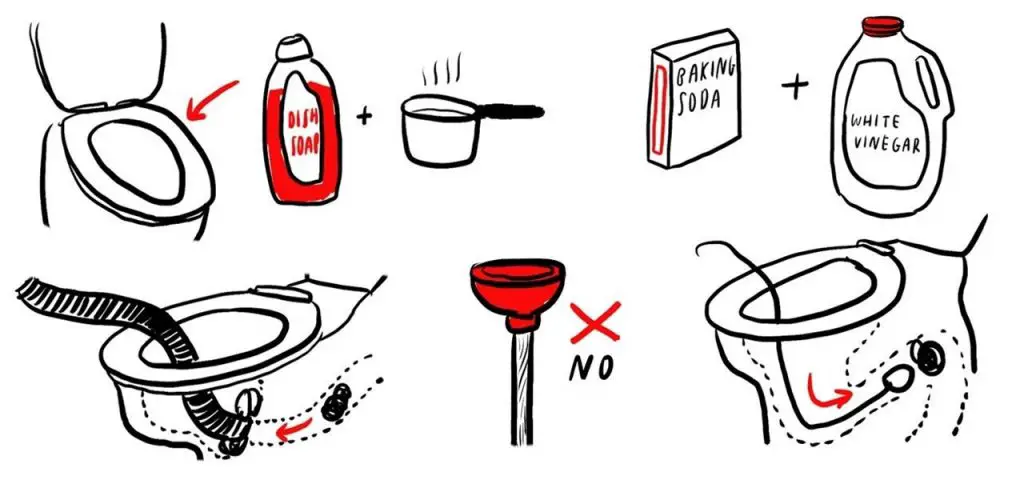 When you experience a clog, removing it quickly is important for avoiding the risk of a flooded bathroom.
When you experience a clog, removing it quickly is important for avoiding the risk of a flooded bathroom.
While using a plunger is the first thought, there are other ways to clear a clog than using the common plunger. In this article, we discuss the different ways of removing clogs and avoiding a flooding mess.
The clog removal methods are:
The most basic methods of removing food and grease work well for unclogging a toilet without a plunger. While they’re not guaranteed, these hacks do have a lot of success among users and they might work for you.
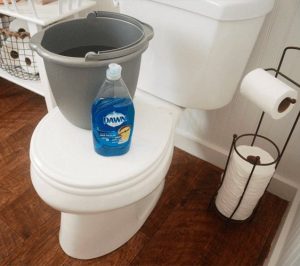 Calling a plumber to remove a toilet clog may not be necessary when using the liquid dish soap method.
Calling a plumber to remove a toilet clog may not be necessary when using the liquid dish soap method.
Degreasing dish liquid, like Dawn or Palmolive liquid, boiling water, and about 15 minutes may get your toilet flowing.
The degreaser in the dish liquid can help break up the fatty solids in the clog.
For tougher clogs, you might need a plunger. But most smaller clogs, the soap, and hot water may be all it takes to get the water flowing.
| Tip:
Many users removing toilet clogs with liquid soap report that liquid laundry soap works better than dish soap. |
Pour a good amount of liquid soap into the toilet bowl. The measurement doesn’t have to be precise, but you want about one-half cup. You should see the dense soap drop towards the bowl bottom.
Let the soap sit in the toilet bowl for 30-40 minutes. Leaving the soap sitting lets it seep into the clog and lubricate the trap way.
While soap sets in the toilet bowl, place 1-gallon of water into a two-handled pot over medium-high heat. Do not boil the water only let small bubbles form on the pot bottom. Water that’s too hot can crack and break the toilet bowl.
After 30 or 40 minutes, carefully yet quickly pour the hot water into the toilet bowl. You want to pour the water fast to create a little force, but be careful about hot water splash back.
Once you add the water, the clog should clear. This method works well, however, if the stool runs slow or starts flooding, you may need to use a plunger.
If this method did not work, many people report success by repeating all the steps again. Some suggest do this at night the second time and wake up with a clog-free toilet.
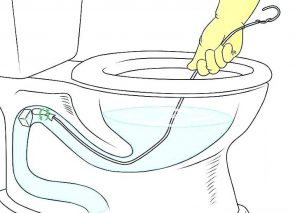 While a plumbing snake or auger can fix most any clog, these are things not always kept around most homes.
While a plumbing snake or auger can fix most any clog, these are things not always kept around most homes.
When you don’t have a plumber’s snake, then quickly make one by using a wire clothes hanger.
For an added layer of protection from scratches to the toilet bowl, use a plastic coated hanger if possible.
If there is too much backup water, empty some of the water before starting to avoid overflow onto the floor.
Unwind the metal clothes hanger, except for the hook, until it is completely straight. Using pliers, close the hook until it’s small enough to fit through the toilet trap way opening. Leave a slight gap between the hook end and wire.
Wrap the small rag around the hook. Tuck the rag ends between the small hook opening to keep the rag in place as much as possible.
If using a plastic coated hanger, you won’t need the rag since the plastic coating protects the bowl from scratches.
Wearing rubber gloves, gently push the hanger through the trap way, angling it until you find the clog. Move the hanger around in circular and up and down movements until the clog clears and the water begins to drain.
Flush the toilet 2 – 3 times to fully clear out the clog and let the toilet drain completely.
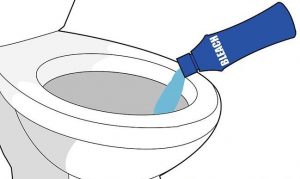 It goes without saying, use extreme caution when using this method for clearing a clog.
It goes without saying, use extreme caution when using this method for clearing a clog.
Bleach is highly corrosive and a harmful chemical that can cause burns and breathing problems. Always make sure children and pets are not close by.
We also recommend using rubber gloves with this method to help protect your skin. Practice extreme caution to avoid splashing.
In addition to helping clear a minor clog, bleach does a fantastic job of disinfecting the toilet.
| Safety Warning:
Never pour baking soda, bleach, or vinegar in your toilet after using a commercial drain opener like Draino. |
Put on rubber gloves, then add one gallon of hot water to the bowl.
Carefully add the two cups of bleach and one cup of powdered detergent to the toilet bowl.
Add enough hot water to fill the toilet bowl halfway, and let the mixture sit for 20 – 30 minutes.
| Note:
Using bleach is not recommended when you have a septic tank system. |
Flush the toilet several times to completely remove the clog.
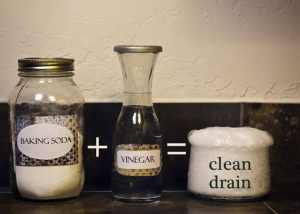 When you have a toilet that frequently clogs from flushing too much waste, this DIY drain cleaner works great.
When you have a toilet that frequently clogs from flushing too much waste, this DIY drain cleaner works great.
However, it only works on organic waste and not hard objects.
Heat water until small bubbles form on the bottom of the pan. Do not let the water boil. Water that’s too hot can crack the toilet bowl.
Pour the cup of baking soda into the toilet bowl then add the two cups of vinegar. The mixture fizzes when you add the vinegar, but this is what you want. This chemical process dissolves the clog.
Pour in the hot water. Make sure you pour the water at waist level height and not against the rim. Pouring from higher up helps add force to remove the clog. Let mixture stand for several hours, preferably overnight then flush.
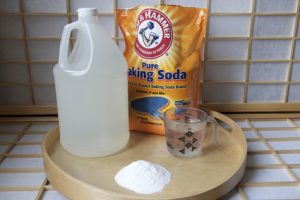 For future clogs, whether in the toilet or other drains, use this simple DIY drainer cleaner.
For future clogs, whether in the toilet or other drains, use this simple DIY drainer cleaner.
Instead of keeping commercial drain openers in the cabinet, this homemade de-clogger takes care of most simple clogs. Plus, this DIY solution is cheaper and safer.
Since you let this recipe dry overnight, it’s best to make them in advance so you have them on hand when you need them. Clogs are worst when they happen with wall-mounted toilets, as the overflow of water can make a serious mess.
Ingredients:
In a medium bowl, mix together the dry ingredients. Add the liquid dish soap to the mixture one tablespoon at a time.
After adding eight tablespoons, mix ingredients together. If the mix is too dry and crumbly, add the remaining two tablespoons of dish liquid.
Pour mixture into individual muffin liners and lightly press the mixture down. Let the de-cloggers set overnight until dry and hard.
Add a de-clogger to the toilet bowl, then add four cups of hot tap water. Let de-clogger sit for 3-4 hours then flush the toilet several times.
Use this method when you leave the house or when you won’t use the toilet for several hours.
It seems like a toilet clog happens at the most undesirable times. Luckily, you can clear many of these clogs yourself, without a plumber and in these cases, a plunger.
While all these unclogging solutions work without a plunger they are only for toilets not overflowing.
For avoiding clogs, help your children understand the toilet is not a place to put toys or other items. Plumbers claim most clogged toilets involve toys or hard items kids flush down the toilet.
Even the best toilets get clogged at times. Another overlooked clog prevention is clogged bowl rim jets. Stopped up rim jets can stop a toilet from flushing with full water power.
Cleaning the bowl and rim with a brush weekly helps keep jets clear. If you do have buildup in the jets, use a screwdriver or small, stiff bristle brush to clear them.
If you find you get toilet clogs regularly, consider calling a plumber. You may have a clog further along in your sewage piping system that needs professional maintenance.
Comments are closed.
My toilet is clogged and this has always been a problem of mine since last week. I never knew that a dish liquid and a gallon of hot water can help unclog a toilet. I’d gladly use this advice, but if this won’t work out, then maybe a plumbing service would be able to address this concern.